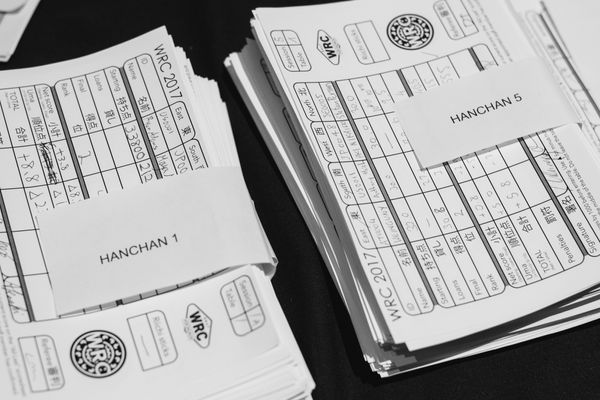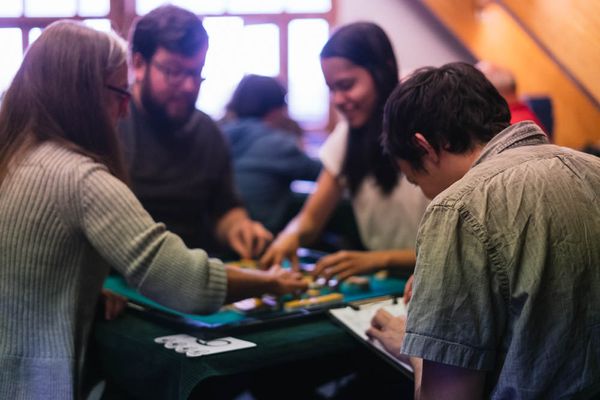[Houou Lab] Looking at Tenhoui ASAPIN’s Calling Part 2 (Calling when cornered, chasing after riichi)
In the first part, we introduced ASAPIN’s criteria for opening his hands, and calling to elongate and switch out shapes. This time, we will discuss melding when you’re cornered, chasing after riichi by melding, this is the essence of ASAPIN’s mahjong technique.
![[Houou Lab] Looking at Tenhoui ASAPIN’s Calling Part 2 (Calling when cornered, chasing after riichi)](/content/images/size/w1200/2018/06/stratdefault.jpg)
Original article by Kentaro on his blog, but was republished on Mahjong Watch recently. Translated by an annoymous translator.
In the first part, we introduced ASAPIN’s criteria for opening his hands, and calling to elongate and switch out shapes. This time, we will discuss melding when you’re cornered, chasing after riichi by melding, and assorted other topics. It’s not exaggeration to say that this is the essence of ASAPIN’s mahjong technique.
Calling when you’re cornered
For us, being “cornered” means a situation in which winning the round would be extremely critical points wise. We’re not talking about getting out of sticky situations on the board.

Currently, ASAPIN doesn’t have a yaku, but it’s totally possible to try and pick up a second  , or to go for chanta, ittsu, or sanshoku. Accordingly, he opens his hand calling the
, or to go for chanta, ittsu, or sanshoku. Accordingly, he opens his hand calling the  to complete the kanchan. There’s no guarantee that he will be able to secure a yaku, but there’s also no guarantee that he would be able to complete this hand closed. Since that’s the case, he’s decided that worrying about the yaku after completing the existing sets would probably be easier.
to complete the kanchan. There’s no guarantee that he will be able to secure a yaku, but there’s also no guarantee that he would be able to complete this hand closed. Since that’s the case, he’s decided that worrying about the yaku after completing the existing sets would probably be easier.

Luckily, he soon draws a second  . Moreover, he’s closer to completing his hand than if he had picked up the second
. Moreover, he’s closer to completing his hand than if he had picked up the second  while keeping his hand closed. Since this hand would have needed some luck to complete either way, one might as well maximize the utility of their potential luck with the
while keeping his hand closed. Since this hand would have needed some luck to complete either way, one might as well maximize the utility of their potential luck with the  chi.
chi.

Soon after, he tsumos the hand without incident. Judging from kamicha’s discards, it wouldn’t have been surprising if a riichi was incoming soon had he not completed the hand.

Third place in oorasu, with a difficult points situation. Ideally one would go for tanyao, but there are not enough potential tanyao sets. Here, ASAPIN chis a completed  set, with a
set, with a  left over to make a second tanyao set. Moreover, by announcing his intentions with this chi, he is also looking to first-place kamicha to help him with useful discards.
left over to make a second tanyao set. Moreover, by announcing his intentions with this chi, he is also looking to first-place kamicha to help him with useful discards.

This is also a tricky points situation, in South 3. Cutting  here and waiting to pon or otherwise complete one of the pairs to take tenpai means giving up sanshoku, but he does so anyways as
here and waiting to pon or otherwise complete one of the pairs to take tenpai means giving up sanshoku, but he does so anyways as  is easier to pon. In a normal round, one would cut
is easier to pon. In a normal round, one would cut  , but he is playing according to the circumstances.
, but he is playing according to the circumstances.
Chasing right after riichi by calling

In this situation, Kamicha has just declared riichi. ASAPIN’s hand, although just one away, is full of difficult shapes.

He chis  to complete a
to complete a 

 set, cutting
set, cutting  . From here, he has five options to call again:
. From here, he has five options to call again: 
 ,
, 
 , and
, and  . Compared to having a weak wait even if he passed here and drew a 3s afterwards, having 5 ways to chi or pon into tenpai is quite strong. It clearly improves his chances to complete the hand.
. Compared to having a weak wait even if he passed here and drew a 3s afterwards, having 5 ways to chi or pon into tenpai is quite strong. It clearly improves his chances to complete the hand.

Despite the double riichi, ASAPIN has somehow worked himself into one away from a dora 2 hand. And to that hand he adds the double dora red  …
…

He chiis, cutting  . Since in this situation it’s likely that he will be taking advantage of kamicha’s discards to chi and pon towards tenpai anyways, he opens here to secure a mangan level hand. There are plenty of tiles that have not yet passed, and his hand does not have any guaranteed safe tiles, so even though it’s a dealer double riichi, there’s no problem with pushing
. Since in this situation it’s likely that he will be taking advantage of kamicha’s discards to chi and pon towards tenpai anyways, he opens here to secure a mangan level hand. There are plenty of tiles that have not yet passed, and his hand does not have any guaranteed safe tiles, so even though it’s a dealer double riichi, there’s no problem with pushing  here.
here.

And he also chiis  here! This was the most enlightening part for me. Although chiing here only increases the possible tile acceptance by
here! This was the most enlightening part for me. Although chiing here only increases the possible tile acceptance by  itself, with the
itself, with the  discard from dealer it wouldn’t be surprising if one of the other two players follows by dropping theirs as well. If that’s the case, it’s clear that chiing here goes a long way in increasing his chances of completing the hand. ASAPIN truly never lets down his guard.
discard from dealer it wouldn’t be surprising if one of the other two players follows by dropping theirs as well. If that’s the case, it’s clear that chiing here goes a long way in increasing his chances of completing the hand. ASAPIN truly never lets down his guard.

In the end, without cutting particularly dangerous tiles, he completes the hand. What’s with this guy, he’s insane!

Here, he pons on the riichi player's  ! He does so to open create the opportunity to accept
! He does so to open create the opportunity to accept  to reach tenpai. It’s amazing enough that he’s able to see this opportunity, but that’s not all.
to reach tenpai. It’s amazing enough that he’s able to see this opportunity, but that’s not all.

He also did it to give himself the haitei tile, although he finishes without reaching tenpai. The useful potential of the  pon would not have been obvious unless one constantly looks out for anything they can do to improve their situation.
pon would not have been obvious unless one constantly looks out for anything they can do to improve their situation.
Assorted other situations

In this situation, he is waiting on 5p for a 2600 hand (as 2p are all visible). Here one should be thinking about….

A  pon!
pon!
Although it becomes a naked tanki, the score improvement, from 2600 to 8000, is very significant. Since the number of winning tiles doesn’t change that much anyways, he pons here. Although cutting  here and waiting on
here and waiting on  would be easy to read, swapping out the
would be easy to read, swapping out the  for whatever comes on the next turn would make the wait completely impossible to read. From the other players’ perspective, even a non-pinzu discards will risk dealing into a 5200 hand, making the situation very difficult for them.
for whatever comes on the next turn would make the wait completely impossible to read. From the other players’ perspective, even a non-pinzu discards will risk dealing into a 5200 hand, making the situation very difficult for them.

This is an interruption pon. The  could very well be a useful tile for the dealer, but ASAPIN denies him even the chance.
could very well be a useful tile for the dealer, but ASAPIN denies him even the chance.

Here he chiis the  , discarding
, discarding  . Although it may not make sense to call already deep into mid-game for only a 2 shanten 1000 pont hand, especially considering the loss in defense, he’s clearly considering these factors at Houou level.
. Although it may not make sense to call already deep into mid-game for only a 2 shanten 1000 pont hand, especially considering the loss in defense, he’s clearly considering these factors at Houou level.
 and
and  are safe against kamicha, and the
are safe against kamicha, and the  ankou is safe against shimocha. Against toimen we only have
ankou is safe against shimocha. Against toimen we only have  , but since
, but since  is a wall,
is a wall,  and
and  are no-chance and almost certainly safe. Chiing here and discarding
are no-chance and almost certainly safe. Chiing here and discarding  is a balance between defensively passing here and aggressively chiing and discarding
is a balance between defensively passing here and aggressively chiing and discarding  . A strong play that aims at moving towards completion while being neither slow nor too aggressive.
. A strong play that aims at moving towards completion while being neither slow nor too aggressive.

This is the first game after reaching tenhoui on his totorisensei19sai account. Points-wise, instead of worrying about losing points, it's more important to try and maximize value here. Currently there is no yaku, but ASAPIN calls an open kan seeking a Rinshan Kaihou. Even after reaching the new stage, he’s not cutting any slack. This isn’t something that would be obvious without daily training, either.

In a normal open hand, to keep the chance to pon, keeping a 556 shape is common sense, but it also depends on the situation. In this situation, keeping the  gives you only the opportunity to receive the two extra
gives you only the opportunity to receive the two extra  tiles, while discarding the
tiles, while discarding the  after ponning the
after ponning the  or
or  would make the resulting
would make the resulting 
 wait incredibly easy to read. Thus, to increases the chances of actually winning the hand, he reduces his ukeire here, using the early discard to camouflage his wait.
wait incredibly easy to read. Thus, to increases the chances of actually winning the hand, he reduces his ukeire here, using the early discard to camouflage his wait.
ASAPIN truly knows how to do everything. He displays high levels of finesse with all his plays. His paifu are probably the best resource for studying how to call and open the hand.
By the way…

The force behind ASAPIN’s strong discards is his extremely high adaptivity. This  is certainly dangerous and shouldn’t be discarded, but most players would have trouble following their intuitions once they have opened their hand. I’d like to look further at ASAPIN’s adaptiveness and situational awareness in the future.
is certainly dangerous and shouldn’t be discarded, but most players would have trouble following their intuitions once they have opened their hand. I’d like to look further at ASAPIN’s adaptiveness and situational awareness in the future.




